520 μJ Microsecond Burst-Mode Pulse Fiber Amplifier with GHz-Tunable Intra-Burst Pulse and Flat-Top Envelope
Abstract
1. Introduction
2. Experimental Setup
3. Experimental Results and Discussion
3.1. Characteristic Pulse Seed and Waveform Pre-Compensation
3.2. The Performance of Burst-Mode Pulse Fiber Amplifier
3.2.1. The Outputting Energy, the Spectrum, and the Temporal Envelope
3.2.2. The Intra-Burst Frequency Tuning Ability and Jitter
3.2.3. The Beam Quality
4. Conclusions
Author Contributions
Funding
Institutional Review Board Statement
Informed Consent Statement
Data Availability Statement
Acknowledgments
Conflicts of Interest
References
- Horowitz, M.; Barad, Y.; Silberberg, Y. Noiselike pulses with a broadband spectrum generated from an erbium-doped fiber laser. Opt. Lett. 1997, 22, 799–801. [Google Scholar] [CrossRef]
- Kobtsev, S.; Komarov, A. Noise-like pulses: Stabilization, production, and application. J. Opt. Soc. Am. B 2024, 41, 1116. [Google Scholar] [CrossRef]
- Obergfell, D.; Azarhoushang, B.; Lasagni, A.F. Investigation of Ablation Efficiency of Stainless Steel Using Pulsed Lasers in Burst Mode. Adv. Eng. Mater. 2023, 25, 2300757. [Google Scholar] [CrossRef]
- Kawabata, S.; Bai, S.; Obata, K.; Miyaji, G.; Sugioka, K. Two-dimensional laser-induced periodic surface structures formed on crystalline silicon by GHz burst mode femtosecond laser pulses. Int. J. Extrem. Manuf. 2023, 5, 015004. [Google Scholar] [CrossRef]
- Li, G.; Yan, A.; Li, Z.; Xing, S.; Shen, W.; Shi, J.; Li, Z.; Shen, C.; Chi, N.; Zhang, J. Burst-Mode Signal Reception for 200 G Coherent Time and Frequency Division Multiplexing Passive Optical Network. J. Light. Technol. 2025, 43, 429–438. [Google Scholar] [CrossRef]
- van Veen, D.; Houtsma, V.; Porto, S.; Basavanhally, N.; Bolle, C.; Schmuck, H. Wavelength-Stable Burst-Mode Laser for Next-Generation PONs. J. Opt. Commun. Netw. 2018, 11, A155–A165. [Google Scholar] [CrossRef]
- Li, G.; Zhou, Q.; Xu, G.; Wang, X.; Han, W.; Wang, J.; Zhang, G.; Zhang, Y.; Song, S.; Gu, S. Lidar-radar for underwater target detection using a modulated sub-nanosecond Q-switched laser. Opt. Laser Technol. 2021, 142, 107234. [Google Scholar] [CrossRef]
- Long, M.; Yang, Y.; Yang, C.; Zhang, H.; Meng, J.; Ding, J.; Deng, H.; Bai, Z.; Zhang, Z. 1 kHz Burst-Mode Infrared 1064 nm Picosecond Laser for Space Debris Laser Ranging. J. Space Technol. Appl. 2024, 4, 245–255. [Google Scholar] [CrossRef]
- Chu, X.; Meng, J.; Wang, H.; Zhu, D.; Yuan, Y.; Huang, L.; Xiang, Z.; Han, J.; Deng, B.; Cui, Y.; et al. Influence of Nitrogen Doping in Vanadium- Compensated 4H-SiC on Transient Photocurrent Response for Photoconductive Microwave Generation. IEEE Photonics Technol. Lett. 2024, 36, 531–534. [Google Scholar] [CrossRef]
- Huang, J.; Hu, L.; Yang, X.; Sun, Y.; Li, X.; Liu, C. Modeling and Simulation of Fe-Doped GaN PCSS in High-Power Microwave. IEEE Trans. Electron Devices 2023, 70, 3489–3495. [Google Scholar] [CrossRef]
- Gu, Y.; Yao, J.; Yue, N.; Yi, M.; Wang, L.; Xun, T.; Yang, H.; Liu, J.; Ge, X.; He, J. Fiber-Induced Optical Reflective Cavity in a High-Voltage SiC Photoconductive Switch to Improve Photoelectric Responsivity. IEEE J. Electron Devices Soc. 2023, 12, 256–261. [Google Scholar] [CrossRef]
- Zhang, J.; Zhang, D.; Fan, Y.; He, J.; Ge, X.; Zhang, X.; Ju, J.; Xun, T. Progress in narrowband high-power microwave sources. Phys. Plasmas 2020, 27, 010501. [Google Scholar] [CrossRef]
- Niu, X.; Wu, Q.; Wang, B.; Yao, J.; Chu, X.; Yi, M.; Gu, Y.; Wang, L.; Xun, T.; Yang, H. Test of KW Class Photonic Microwave Generation Using Vanadium-Compensated 6H-SiC PCSS and Burst-Mode-Operation Pulse Laser. IEEE Photonics J. 2023, 15, 5500407. [Google Scholar] [CrossRef]
- Chu, X.; Xun, T.; Wang, L.; Yang, H.; Liu, J.; He, J.; Zhang, J. Wide-Range Frequency-Agile Microwave Generation up to 10 GHz Based on Vanadium-Compensated 4H-SiC Photoconductive Semiconductor Switch. IEEE Electron Device Lett. 2022, 43, 1013–1016. [Google Scholar] [CrossRef]
- Ortega-Gonzalez, F.J.; Tena-Ramos, D.; Patino-Gomez, M.; Pardo-Martin, J.M.; Madueno-Pulido, D. High-Power Wideband L-Band Suboptimum Class-E Power Amplifier. IEEE Trans. Microw. Theory Tech. 2013, 61, 3712–3720. [Google Scholar] [CrossRef]
- Fang, W.-R.; Huang, W.-H.; Huang, W.-H.; Li, J.-W.; Fu, C.; Wang, L.-L.; He, T.-W.; Cao, Y. X-Band High-Efficiency High-Power GaN Power Amplifier Based on Edge-Triggered Gate Modulation. IEEE Microw. Wirel. Compon. Lett. 2020, 30, 884–887. [Google Scholar] [CrossRef]
- Capmany, J.; Mora, J.; Gasulla, I.; Sancho, J.; Lloret, J.; Sales, S. Microwave Photonic Signal Processing. J. Light. Technol. 2013, 31, 571–586. [Google Scholar] [CrossRef]
- Marpaung, D.; Yao, J.; Capmany, J. Integrated microwave photonics. Nat. Photonics 2019, 13, 80–90. [Google Scholar] [CrossRef]
- Ma, C.; Yang, Y.; Liu, C.; Fan, B.; Ye, X.; Zhang, Y.; Wang, X.; Pan, S. Microwave Photonic Imaging Radar with a Sub-Centimeter-Level Resolution. J. Light. Technol. 2020, 38, 4948–4954. [Google Scholar] [CrossRef]
- Yu, H.; Zhang, J.; Qi, Y.; Zhang, L.; Zou, S.; Wang, L.; Lin, X. 85-W Burst-Mode Pulse Fiber Amplifier Based on a Q-Switched Mode-Locked Laser with Output Energy 0.5 mJ per Burst Pulse. J. Light. Technol. 2015, 33, 1761–1765. [Google Scholar] [CrossRef]
- Zhang, J.; Li, D.; Cheng, W.; Zhang, H. Amplification and frequency quadrupling of picosecond long duration burst-mode laser. Opt. Laser Technol. 2023, 158, 108848. [Google Scholar] [CrossRef]
- Gu, Y.; Niu, X.; He, T.; Yi, M.; Yao, J.; Wang, L.; Xun, T.; Liu, J. 26.6 μJ microsecond tunable burst-mode pulsed laser based on synchronous pumping. In Proceedings of the International Conference on Optics and Machine Vision (ICOMV 2024), Nanchang, China, 19–21 January 2024; SPIE: St Bellingham, WA, USA, 2024; pp. 55–59. [Google Scholar]
- Huang, C.; Deibele, C.; Liu, Y. Narrow linewidth picosecond UV pulsed laser with mega-watt peak power. Opt. Express 2013, 21, 9123–9131. [Google Scholar] [CrossRef] [PubMed]
- Li, F.; Zhao, W.; Fu, Y.; Xing, J.; Wen, W.; Wang, L.; Li, Q.; Cao, X.; Zhao, H.; Wang, Y. High-Power GHz Burst-Mode All-Fiber Laser System with Sub 300 fs Pulse Duration. Photonics 2024, 11, 570. [Google Scholar] [CrossRef]
- Li, S.C.; Huang, T.L.; Hsieh, Y.H.; Liang, H.C.; Huang, K.F.; Chen, Y.F. Generation and characterization of burst modes in passively mode-locked lasers with internal Fabry–Perot cavities. Opt. Lett. 2019, 45, 61–64. [Google Scholar] [CrossRef]
- Han, L.; Wang, T.; Liu, R.; Ma, W.; Zhao, Y.; Fu, Q.; Jiang, H. Generation of Flat-Top Q-Switched Envelope Dissipative Soliton Resonance Pulse in Passively Mode-Locked Fiber Laser. IEEE Photonics J. 2020, 12, 7101508. [Google Scholar] [CrossRef]
- Kerse, C.; Kalaycıoğlu, H.; Elahi, P.; Akçaalan, Ö.; Ilday, F.Ö. 3.5-GHz intra-burst repetition rate ultrafast Yb-doped fiber laser. Opt. Commun. 2016, 366, 404–409. [Google Scholar] [CrossRef]
- Barua, S.; Das, N.; Nordholm, S.; Razaghi, M. Comparison of pulse propagation and gain saturation characteristics among different input pulse shapes in semiconductor optical amplifiers. Opt. Commun. 2016, 359, 73–78. [Google Scholar] [CrossRef]
- Šajn, M.; Petelin, J.; Agrež, V.; Vidmar, M.; Petkovšek, R. DFB diode seeded low repetition rate fiber laser system operating in burst mode. Opt. Laser Technol. 2017, 88, 99–103. [Google Scholar] [CrossRef][Green Version]
- Zhang, H.; Deng, D.; Zu, J.; Chen, J.; Li, D. Numerical Model of Chirped Pulse Amplification in Pulsed Synchronously Pumped Low-Repetition-Rate Fiber Amplifiers. IEEE Photonics J. 2021, 13, 1500511. [Google Scholar] [CrossRef]
- Zhang, H.; Shen, X.; Chen, D.; Zheng, C.; Yan, P.; Gong, M. High energy and high peak power nanosecond pulses generated by fiber amplifier. IEEE Photonics Technol. Lett. 2014, 26, 2295–2298. [Google Scholar] [CrossRef]
- Frantz, L.M.; Nodvik, J.S. Theory of Pulse Propagation in a Laser Amplifier. J. Appl. Phys. 1963, 34, 2346–2349. [Google Scholar] [CrossRef]
- Schimpf, D.N.; Ruchert, C.; Nodop, D.; Limpert, J.; Tünnermann, A.; Salin, F. Compensation of pulse-distortion in saturated laser amplifiers. Opt. Express 2008, 16, 17637–17646. [Google Scholar] [CrossRef] [PubMed]
- Černe, L.; Petelin, J.; Petkovšek, R. Femtosecond CPA hybrid laser system with pulse-on-demand operation. Opt. Express 2020, 28, 7875–7888. [Google Scholar] [CrossRef] [PubMed]
- WaveRunner 9000 and WaveRunner 8000-R Oscilloscopes Operator’s Manual; Teledyne LeCroy: Chestnut Ridge, NY, USA, 2022.
- Niu, X.; Gu, Y.; Chu, X.; Yao, J.; Yi, M.; Wang, L.; Xun, T. Primary study on time control technology of active phased array based on photoconductive microwave source. High Power Laser Part. Beams 2024, 36, 013005. [Google Scholar] [CrossRef]

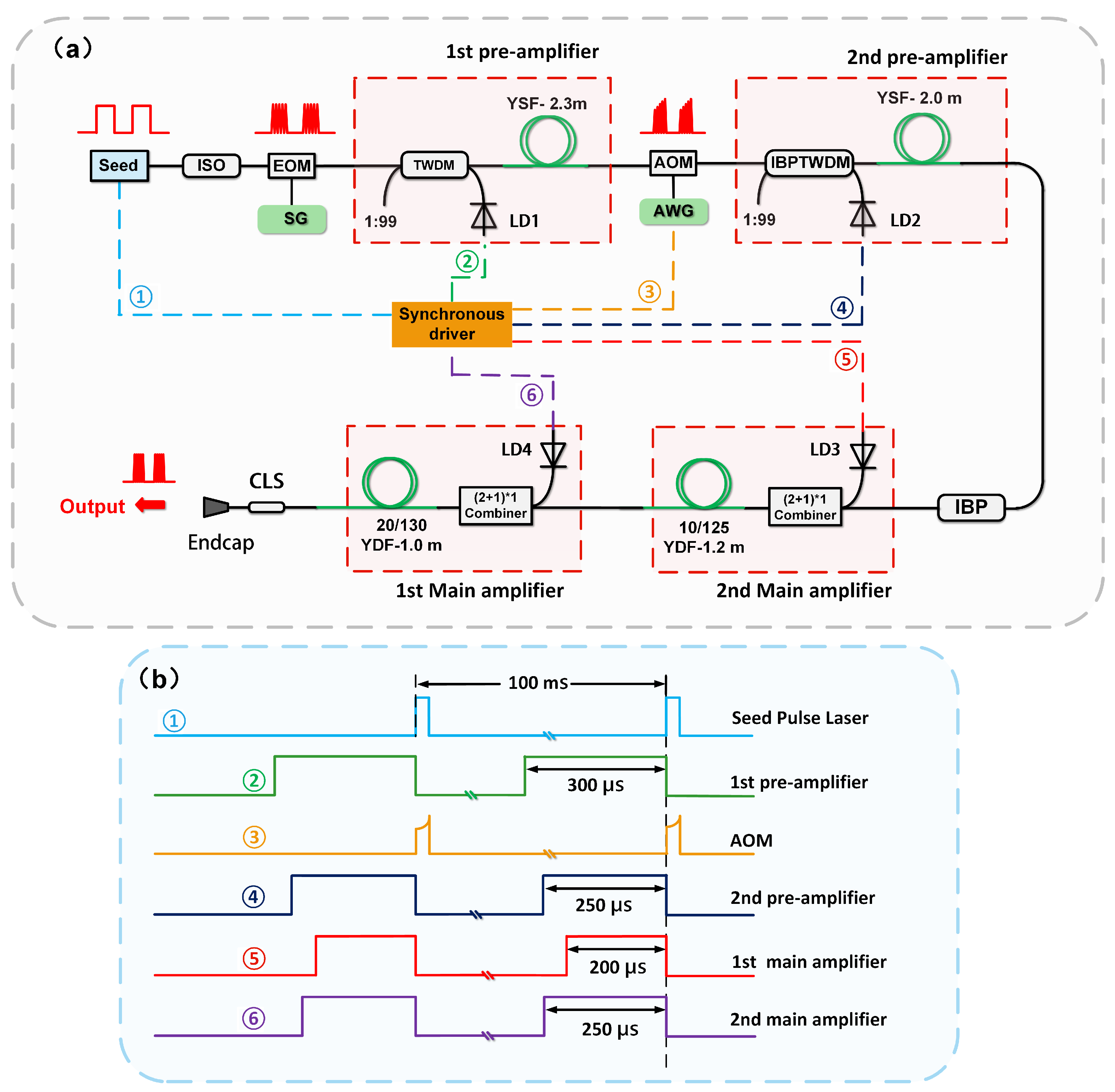
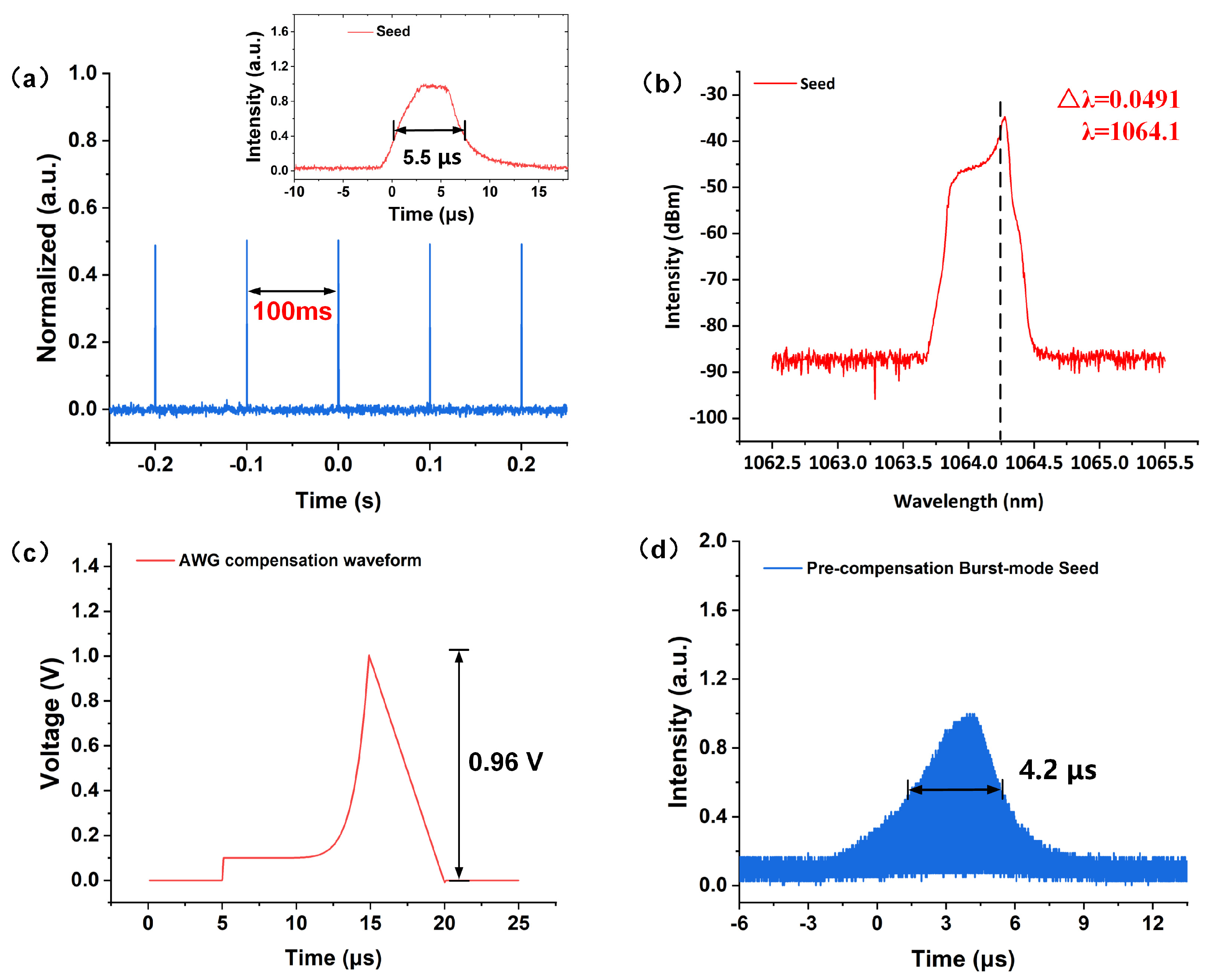
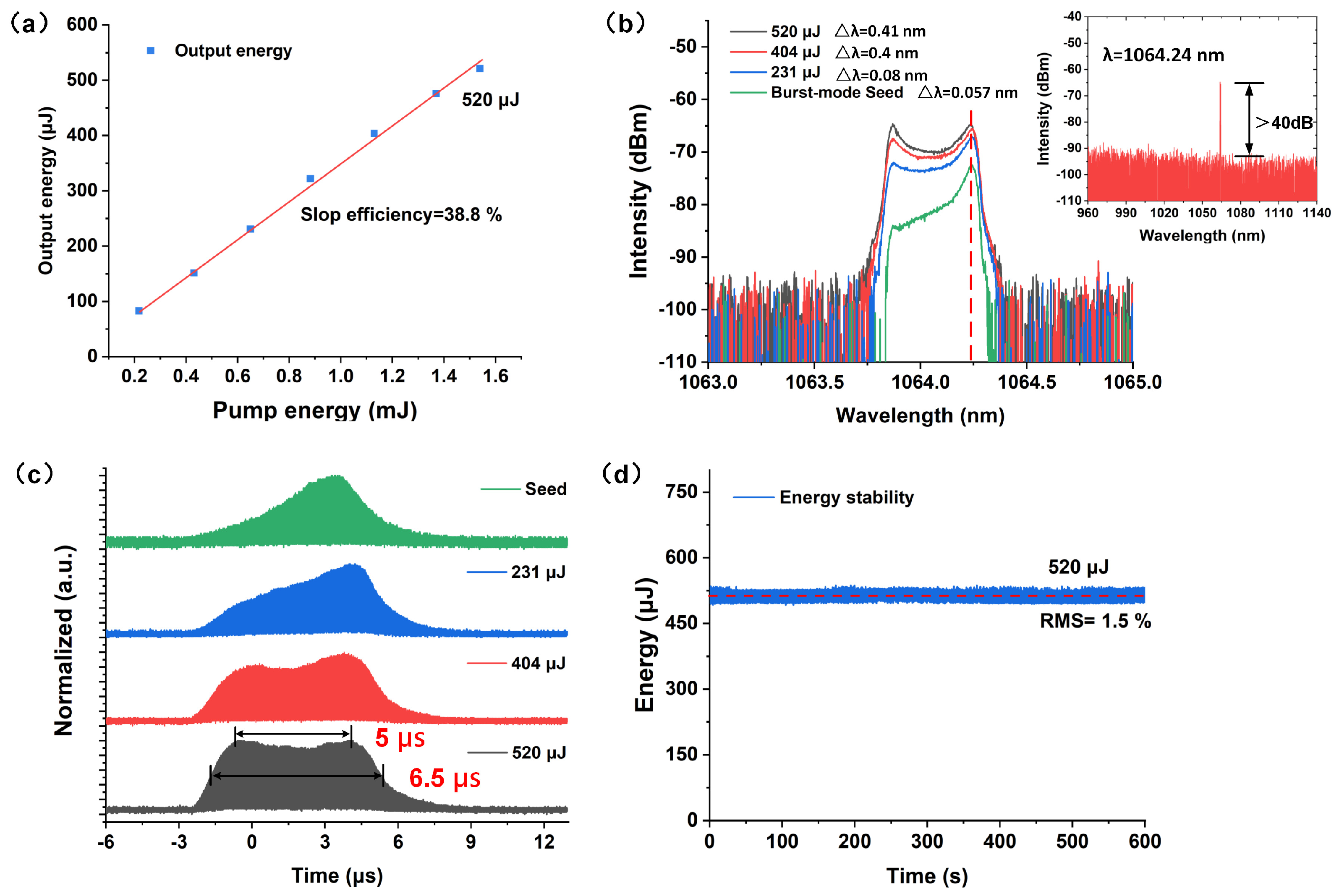
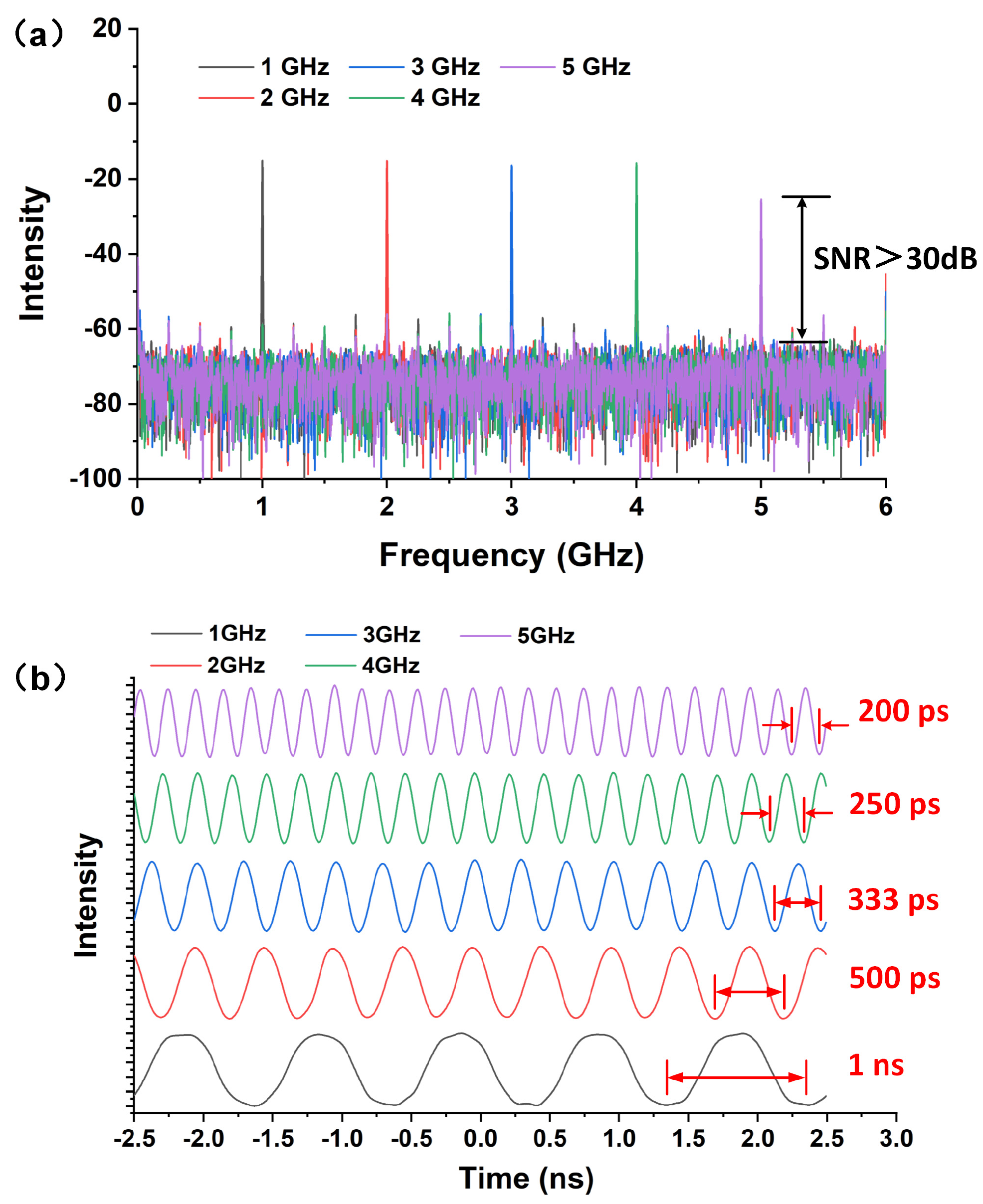

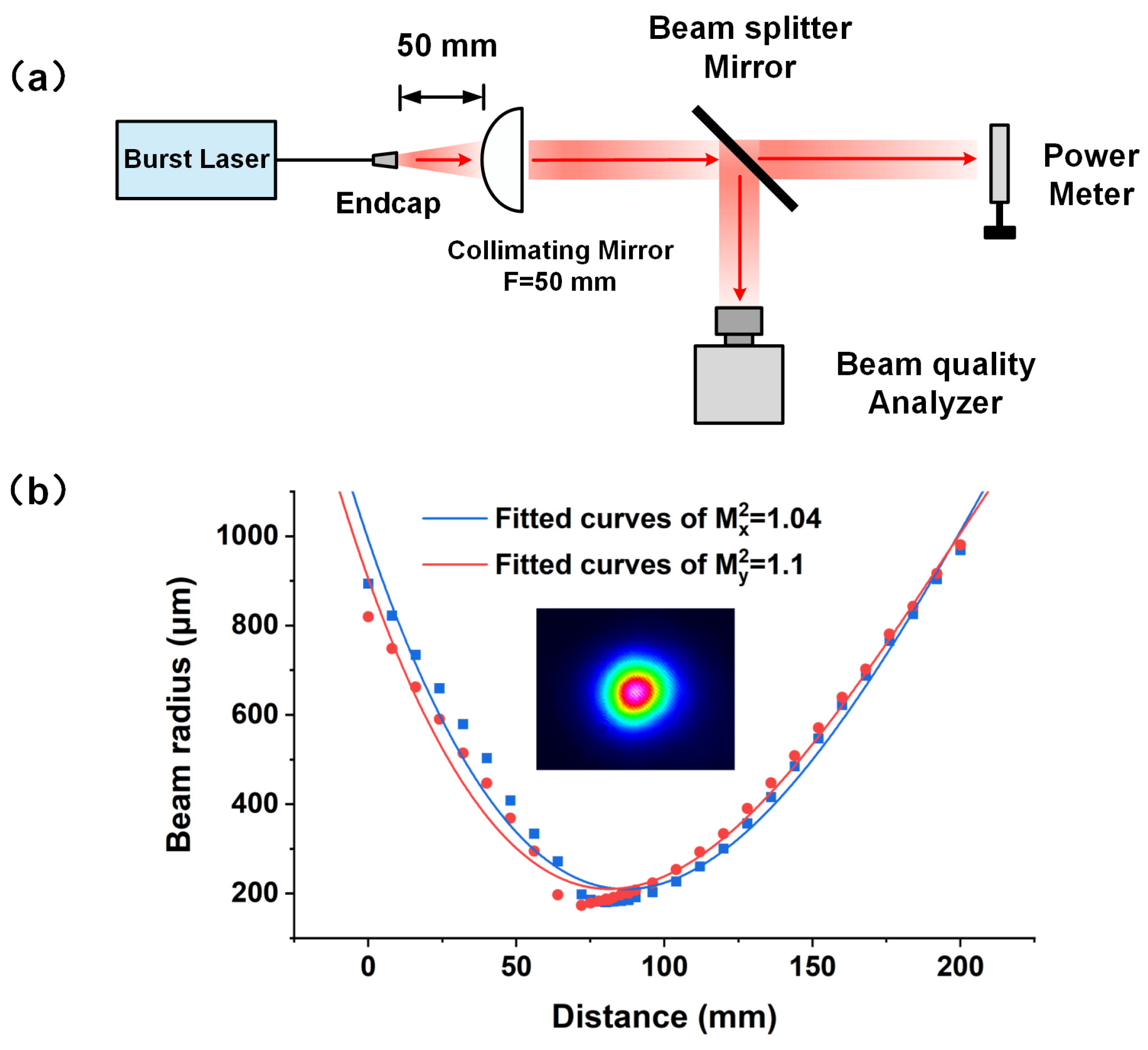
Disclaimer/Publisher’s Note: The statements, opinions and data contained in all publications are solely those of the individual author(s) and contributor(s) and not of MDPI and/or the editor(s). MDPI and/or the editor(s) disclaim responsibility for any injury to people or property resulting from any ideas, methods, instructions or products referred to in the content. |
© 2025 by the authors. Licensee MDPI, Basel, Switzerland. This article is an open access article distributed under the terms and conditions of the Creative Commons Attribution (CC BY) license (https://creativecommons.org/licenses/by/4.0/).
Share and Cite
Gu, Y.; Niu, X.; Yi, M.; Yao, J.; Wang, L.; Xun, T.; Liu, J. 520 μJ Microsecond Burst-Mode Pulse Fiber Amplifier with GHz-Tunable Intra-Burst Pulse and Flat-Top Envelope. Photonics 2025, 12, 97. https://doi.org/10.3390/photonics12020097
Gu Y, Niu X, Yi M, Yao J, Wang L, Xun T, Liu J. 520 μJ Microsecond Burst-Mode Pulse Fiber Amplifier with GHz-Tunable Intra-Burst Pulse and Flat-Top Envelope. Photonics. 2025; 12(2):97. https://doi.org/10.3390/photonics12020097
Chicago/Turabian StyleGu, Yanran, Xinyue Niu, Muyu Yi, Jinmei Yao, Langning Wang, Tao Xun, and Jinliang Liu. 2025. "520 μJ Microsecond Burst-Mode Pulse Fiber Amplifier with GHz-Tunable Intra-Burst Pulse and Flat-Top Envelope" Photonics 12, no. 2: 97. https://doi.org/10.3390/photonics12020097
APA StyleGu, Y., Niu, X., Yi, M., Yao, J., Wang, L., Xun, T., & Liu, J. (2025). 520 μJ Microsecond Burst-Mode Pulse Fiber Amplifier with GHz-Tunable Intra-Burst Pulse and Flat-Top Envelope. Photonics, 12(2), 97. https://doi.org/10.3390/photonics12020097



